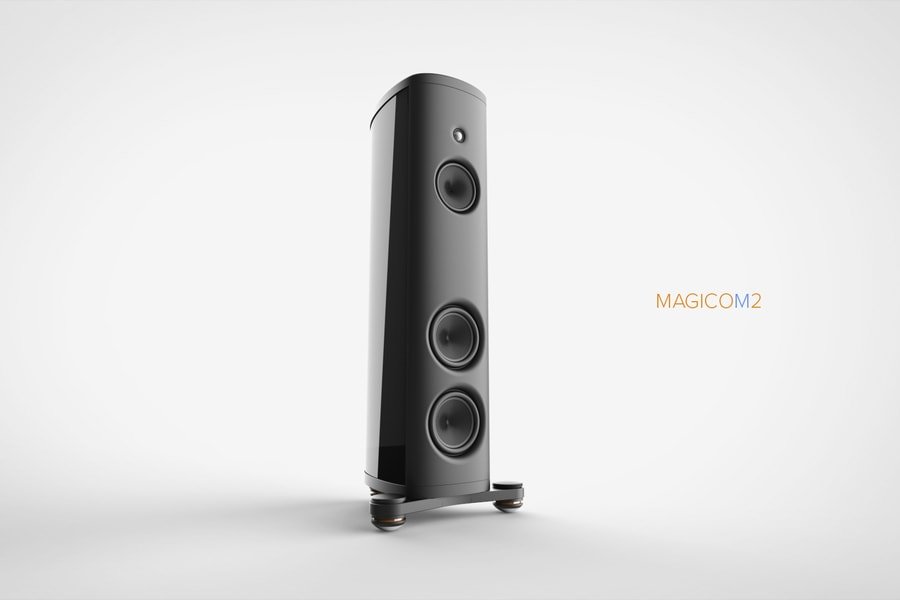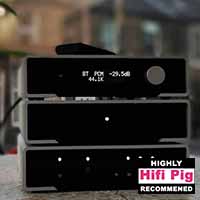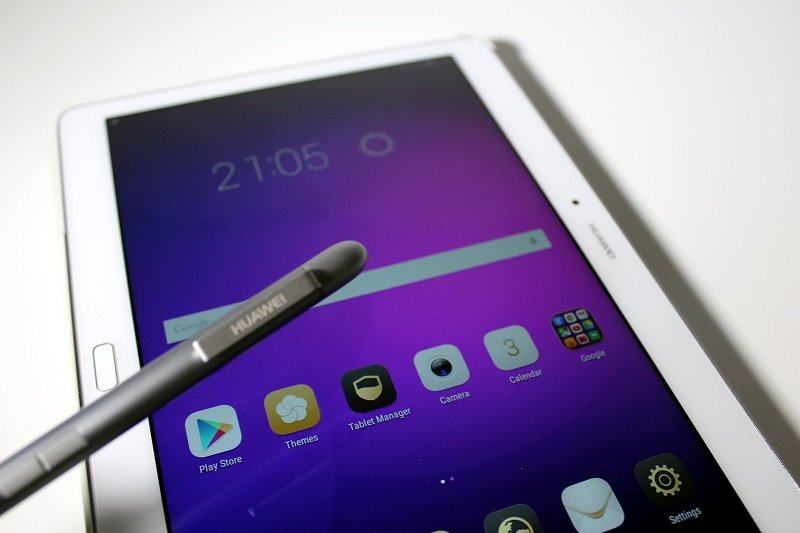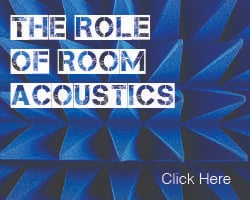Continuing her excellent series focusing on vintage and classic hifi, Janine Elliot takes a look at the Meridian M2 active loudspeakers. 
The 1970’s brought a number of iconic hifi separates, and some even looked beautiful. Two such products were the Lecson AP1 tower power-amp and rainbow coloured fader adorned AC1 preamp; both making their way to the New York Museum of Modern Art, the Victoria and Albert Museum London, and winning a British Design Council Award in 1974 . 
With electronics by Bob Stuart and industrial design by Allan Boothroyd this amplifier and preamp was like nothing else, beautiful though not quite in the petite scale of B&O. This was a statement. The company was sold in 1974 to an Indian who was more used to selling sugar, as the AP1 was rather unreliable, leading then to the more reliable AP1X and AP3. The FM1 with its multiple LEDs and massive tuning wheel was even more amazing to my young eyes in 1978 when it hit the stores. A very rare product if you can ever get your hands on one. Only by looking at the inside of the AC1 repairing one for a friend, did I realise the infancy of the company; the multi-coloured slider controls were held together with matchsticks and the multi coloured sliders had magnets glued on their underside that controlled magnetic switches to turn functions on and off as moved them up and down. This was no mass-produced Japanese design. This had the markings of human love and sweat.
The company, formed in 1972, was Bob Stuart and Allen Boothroyd’s first major project, though they had been working as consultants since the early 70’s. They were joined by John Greenbank (later of Tangent Acoustics). These three left the company in 1974 when it was saved from bankruptcy, to be replaced by Stan Curtis (from Cambridge Audio) as Managing Director, plus Mike Harris. I loved the look of this AP1/AC1 when I first saw it. Whilst its reputation wasn’t quite as long-lasting as its looks, this gave the original designing duo a foothold into the audiophile almanac. Luckily Bob and Allen didn’t end their exploration there but went on to initially to make Orpheus amplifiers (1975) and then to set up Meridian in 1977, just before their original company Lecson died in 1978 to be revived temporally by Stan Curtis again and then bought by Debenhams who killed it off when they themselves were bought out. Such is the jungle of the business world.
Bob and Alan’s new company equipment was to be badged as ‘Boothroyd Stuart Meridian’, rather than simply their company name ‘Meridian Audio Limited’ just to be even more confusing, or to remind us who the designers were. The name “Meridian” arises from their factory was on the Greenwich Meridian, being based in Huntingdon, just south of that line, in Cambridgeshire, winning more than 165 awards, including three Design Council Awards. Very importantly the products are hand-made in the UK.
Boothroyd was also famed for designing the BBC Micro Computer in 1981 (which he says took him a day and a half) and the Pioneer Elite speaker system. His and Stewart’s expertise in the digital world led to designing Britain’s first CD player in 1983 (based on the Philips CD100, and for whom Bob Stewart had done digital work for) then the 1985 MCD Pro at £675, the first digital surround processor, the first DSP based digital active speakers and the lossless audio format called MQA. Meridian even made some of the first CD recorders, aimed particularly for recording studios, and let’s not forget some of the best looking remote controls.
The duo’s first ever loudspeaker was not the Meridian M1 or 2, but the Lecson HL1, the SP1, and finally the HiFi Pig friendly name of LB1 Lynette, whilst under the Lecson label. This very advanced ‘angled’ shape speaker was actually Lecson’s most successful, though it could have flopped had they stuck with the originally intended name of “Lecson Lillette”, sounding more like a ladies sanitary product than a piece of hifi! This speaker used a Dalesford 8 inch bass driver in the pre-production model but was then changed to a KEF B200 plus a T27 KEF tweeter, and unusually with two front ports; one at the bottom and one next to the tweeter. Both were filled with straws, working as a resistive loading to the motion of the horns, something I will mention again later, which controlled the lowest frequency sounds, prevent a sort of ‘honking’ horn sound. When Boothroyd Stewart set up Meridian in 1977 their first product was the M1, a large wedge-shaped floor-standing speaker (literally sitting on the floor) with the power-amp sitting in a gap at the bottom. Not many still exist today; indeed Meridian didn’t even have a working model of their own until 25 years later a past customer offered them his own when moving to a smaller house.
Their fifth attempt at speakers in 1979 was the one that turned Meridian into a household name. High Fidelity magazine referred to it as “An astonishing speaker from Great Britain” when it was priced in high $/£ exchange rates at $2900 in a gorgeous rosewood or $2700 in walnut or black. While that meant the product was around £750 in Blighty for each of the 7 finishes or £825 in beautiful Rosewood or Yew in 1979, this was still a relatively expensive price to pay. Meridian claimed that it was actually cheaper than it could be based on the fact that with the amplifiers (two of them) inside the speaker, then there was no need to pay extra for a separate box. It also meant that the amplifiers could be tailored exactly to give the best sound for the speaker design, matching the characteristics of the drivers. I drooled at it in KJ LeisureCentre and even doodled the front baffle on numerous pages of my school books. I had never seen a speaker with a KEF T52 tweeter stuck between two B110 woofers, and a port filled with those drinking straws, or that the whole speaker’s footfall was thin and deep with speaker stand screwed into it. I eventually bought one second-hand in the noughties. My speaker is in the most common walnut wood- grain-matched veneer. The wood itself was A-grade Birch plywood of 14mm width, braced and damped internally.
The M2 is unique in a number of areas. Firstly the crossover frequency is down at 1900Hz, below that all important 3KHz area that fails in so many 2-ways, something that could only be done in an active speaker design. Not only this, but the two iconic KEF B110’s are mounted in line either side of a T52. The two B110’s were needed in order to get the low frequency power down to the claimed 38Hz at -3dB. 38Hz from 5” midrange speakers was unheard of. Adding an electronic crossover adjusted to produce an acoustic 4th order crossover shape, and with a time delay of 76 microseconds so that it is in phase with the woofers, creates a unique radiation pattern. Indeed Bob and Stuart designed the M2 so that at low frequencies the three drivers combine through acoustic coupling to produce the equivalent of a single driver of around 12” x 5” . With the tweeter at the centre the aim was to produce a single point of reference (any of you remember those EMI elliptical drivers with centrally fixed ‘bridge’ holding a tweeter 50 years go?) To be able to do this, though, they needed to have an integral amplifier system, hence the 70W bass and 35W tweeter Class-A amplifiers. The amplifiers inside are affixed to the back plate of the speaker and are similar to the 105 power amps, and create less than 0.01% distortion, which was still very good in its day. The wiring using DIN sockets allowed at pins 1 and 5 balanced input from the 101B balanced pre-amplifier. Bearing in mind the long cable runs between the speakers and pre-amplifier, the unit preferred the balanced approach, though interestingly is the fact that there are only two wires (one red and one white). The clever design in the M2 was to reduce the size of the M1 down to 17 litres. This was not simply an amplifier and speaker literally bolted together; the amplifier was not merely the 105 power amplifier, but rather a well-designed engine built solely to make the M2 sound good. The electronic crossover had components tailored to match exactly the drivers (drivers are habitually variable in sound one to another, by as much as 1 to 3dB), and the design allows the bass to go down to 38dB. Had just a 105 been connected then that bass end would end at around 60dB. That interactive crossover employed originally in the M1 worked so very well, and so was used in this, their next speaker. The advantages of being active speakers is not only in the reduced price of combining speaker and amp, but also that that the amplifiers can be tailed exactly to the speakers; tweeters do not need such high power as woofers, so a smaller tweeter amplifier is perfect, rather than using a single amplifier for all frequencies. Also, because the crossover built in most speakers is post-amplification, they need to be fairly high grade and expensive passive components. Since the signal into either amplifier in the M2 is at much lower level a much more elegant cheaper array of semiconductor filtering to the respective amplifiers can be used. It means the amplifier, the crossover module and the speakers work together in better harmony. Also, the beauty of having amplifiers on-board the speakers meant that the drivers could never be overloaded, fed wrong impedance, or more importantly not match the speaker design itself.
The sound itself could be described as very precise and forward, with a deep bass that sounded somewhat “created” rather than natural of which some listeners could find slightly coarse. There are impeccable imaging and dynamics, and a very transparent sound but all these added together would please some listeners but not others. The sound is very marmite; you either love the detail and timing or you find the sound tiring and unreal, or a mixture of all four. Mid-band detail is excellent, largely because of the lower crossover point, but sometimes the top-end can sound lame. The accompanying 101 and 101B preamplifiers were ‘miniature’ designs taking the industry by surprise at a time of silver fronted (and then black fronted) butch 17” wide separates. The preamp had only a dual volume control (allowing alteration of left and right independently) plus switching on of this and the M2 powered speakers linked from the 101’s output, a bit like as in a Quad 33 or Leak Varislope preamplifiers. It had just 3 switches to alter between phono and radio (the 104 tuner) and tape output plus mono/stereo. The inside was similarly modular with the supplied MM cartridge module being switchable to the MC version (which also worked with high output MMs). Something that has regularly annoyed audio fans is the use of DIN plugs in their equipment, just as Naim , Linn and B&O has done in their products, though their use has meant the foot-fall of these products could be therefore reduced. Whilst suitable audiophile cables are not so easily accessible, they are still available for significant upgrading over the OEM cables supplied. The mains and line-out cable to the respective speakers is considerable length, allowing them to be tucked well out of the way, but this has meant a certain amount of sound degradation, though the balanced architecture reduces this, and in the 1970’s cable choice was of course not such a major concern as it is today. There is a common toroidal power supply for both the 70W and 35W amplifiers. Typical of the 101/101B preamp is a plug-in electronic crossover inside the speakers to allow replacement with an alternative if the speaker is to be sized as a bookshelf (the shelf would have to be very deep!)
I am an avid fan of amplified speaker designs, since the first Philips Motional feedback speakers, which pre-date the M1 and M2, beating them to the post by a few years. Actually, professional musicians have had powered speakers for many, many years and the first powered speaker designs actually go back to 1930’s but it seems the M2 is the one that will stick in the minds of audiophiles as the one that began it all. The M2 was soon to be joined by stand mount M3 and the iconic floor-stander M10, leading to the first of the digital active speakers, the P10, and then the DSP series to this day. The M2 might well have been Bob and Alan’s Fifth Avenue, but it certainly laid the foundations for their road to success.
Janine Elliot
READ MORE RETRO BITES WITH JANINE ELLIOT










































































































































































































You must be logged in to leave a reply.